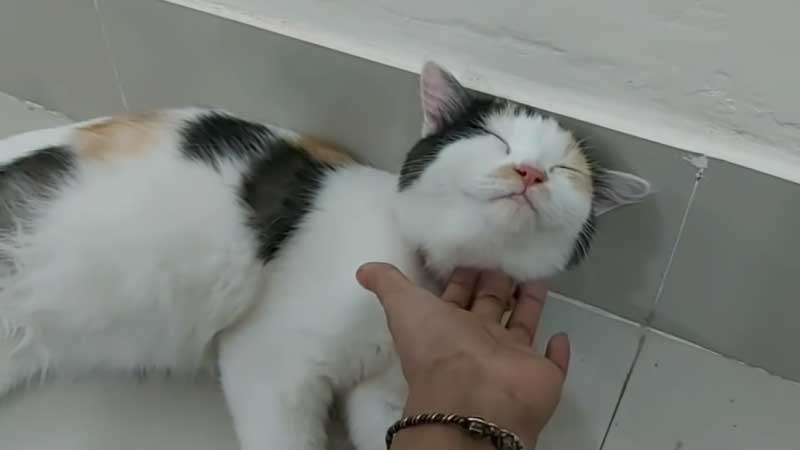The litter box is one of the most important things to consider when keeping our feline friends healthy and happy. With so many different types of cat litter boxes on the market, choosing the right one for your cat can be challenging.
In this blog post, we’ll be breaking down the top 11 different types of cat litter boxes available, so you can make an informed decision on the best option for your furry companion.
From traditional to self-cleaning, top-entry to designer, we’ve got you covered. So, whether you’re a first-time cat owner or simply looking to upgrade your current setup, read on to learn about the different types of cat litter boxes available and which is right for you and your feline friend.
11 Different Types of Cat Litter Boxes
- 11 Different Types of Cat Litter Boxes
- 1. Traditional Cat Litter Boxes
- 2. Open Litter Boxes
- 3. Sifting Cat Litter Boxes
- 4. Self-Cleaning Cat Litter Boxes
- 5. Top-entry Cat Litter Boxes
- 6. Corner Cat Litter Boxes
- 7. Disposable Cat Litter Boxes
- 8. Designer Cat Litter Boxes
- 9. Dog Proof Litter Boxes
- 10. Portable Litter Boxes for Travel
- 11. High Sided Litter Boxes
- Which Litter Box is Right for You?
- Are Open or Closed Litter Boxes Better?
- How Many Litter Boxes Should You Have?
- Do Cats Like Deep or Shallow Litter Boxes?
- Final thoughts
Many different types of cat litter boxes are available on the market today. Among the most popular types are traditional, sifting, automatic, self-cleaning, top-entry, hooded, corner, disposable, designer, dog-proof, portable, and high-sided litter boxes. Each type of litter box has its own unique features, benefits, and drawbacks. Below we have discussed in detail and suggested the most suitable one for you.
1. Traditional Cat Litter Boxes

A traditional cat litter box is one of the most basic types of cat litter boxes that are available on the market today. A variety of shapes and sizes are available, and they are typically made out of plastic in various colors. They usually come in rectangular or square shapes and have a low profile, making it easy for your cat to step in and out of them easily. These types of litter boxes are often the most affordable option and are widely available in pet stores and online.
Simplicity is one of the main advantages of traditional cat litter boxes. Their use is easy, and most cats enjoy using them. Additionally, they tend to be more cost-effective than other litter boxes. Litter boxes can also be easily cleaned since they can be scooped out and wiped down quickly.
On the downside, traditional cat litter boxes can be unsightly and may not fit with your home’s decor. A strong odor can also result from the accumulation of waste, which can be difficult to remove. Moreover, more frequent cleaning is required, since litter needs to be changed more frequently than in other litter boxes.
2. Open Litter Boxes

The open litter box or uncovered litter box is a type of litter box that does not have a lid or cover. These containers are typically simple and open, allowing cats to easily access the litter. In fact, they are the most basic type of litter box and come in a variety of shapes, sizes, and colors.
A main advantage of open litter boxes is that they are easily accessible for cats, and because of this, they are ideal for cats who may find it difficult to climb over high walls or into covered litter boxes. Also, they are usually the most affordable option and are relatively easy to clean, making them an excellent choice.
There are a few downsides to open litter boxes. One is that they may not contain as much odor as covered litter boxes and can be more likely to scatter litter around the house. There is also the possibility that they may not be as private as they would like for cats that prefer enclosed spaces.
3. Sifting Cat Litter Boxes
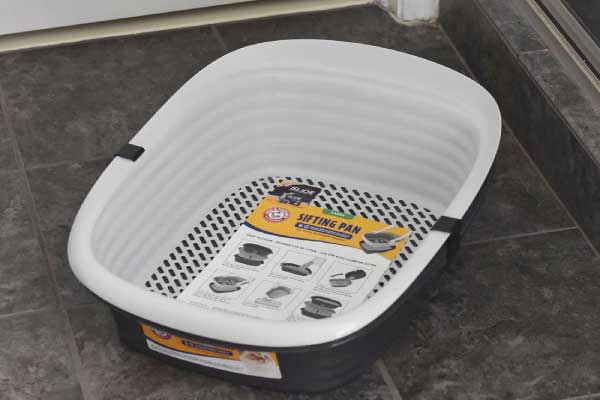
A sifting cat litter box is a particular type of cat litter box that employs a sifting mechanism to separate the waste from the clean litter in the box. These are typically made up of a plastic tray with a mesh screen or grating attached to the bottom on a mesh screen. The clean litter falls through the mesh while the waste is caught on top of it. The waste can then be easily removed, leaving clean litter behind.
A major benefit of sifted cat litter boxes is that they are extremely easy to clean. Due to the separate waste and clean litter, it is easy to remove the waste and leave the clean litter. Also, the waste is removed more frequently, which reduces odors. Additionally, sifting cat litter boxes are more hygienic since they effectively remove feces and urine.
However, it is important to note that sifting cat litter boxes can be more expensive than traditional litter boxes and may require replacement parts over time. While in use, the sifting mechanism may make some noise, which may not be ideal for all cats. A heavy digger cat can also clog the sifting mechanism very quickly.
4. Self-Cleaning Cat Litter Boxes
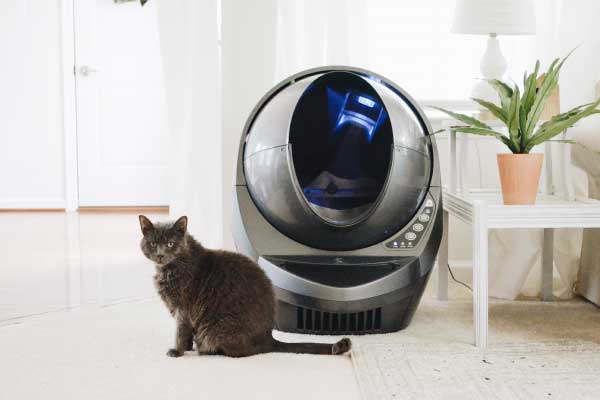
A self-cleaning cat litter box is also called an automatic cat litter box because it uses an electronic or mechanical system to clean the litter automatically. Typically, they feature a base unit with a motor and a removable waste container. Usually, the litter is raked or sifted automatically, so that it can be separated from the waste litter and cleaned litter. As soon as the waste is collected, it is deposited into a receptacle, which is easily removable and replaceable if necessary.
There are many benefits to using self-cleaning cat litter boxes such as the fact that they require very little maintenance on your part. By automatically removing the waste, you won’t have to scoop the litter or change the litter as often. This will save you a lot of time and effort, especially if you have more than one cat at home. It is also beneficial to have self-cleaning cat litter boxes, as they remove the waste from the box more often, which helps to reduce odors.
On the downside, self-cleaning cat litter boxes can be more expensive than traditional or sifting litter boxes and may require replacement parts over time. The mechanical or electronic system can also be noisy, which may not be ideal for all cats. Also, some cats may not take to using a self-cleaning litter box and may prefer a more traditional option.
5. Top-entry Cat Litter Boxes
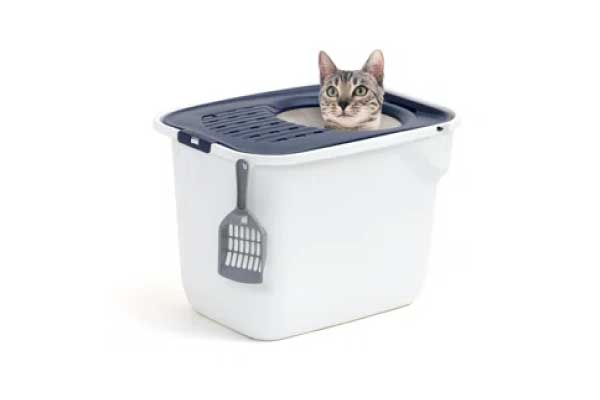
The top-entry cat litter box, also called a hooded cat litter box, is a type of cat litter box with a cover or hood on top of it, making it a type of hooded litter box. Typically, they are made up of a plastic tray with a removable lid or hood covering the top. As a result of the cover or hood, litter scatter is kept contained and odors are reduced. Several top-entry litter boxes also come equipped with an integrated filter that prevents odors from entering through the top.
One of the main benefits of top-entry cat litter boxes is that they help to contain litter scatter. The cover or hood on top prevents cats from kicking litter out of the box and onto the floor. This can help to keep your home cleaner and reduce the need for frequent litter changes. Top-entry cat litter boxes also help to reduce odors as the cover or hood contains the waste.
On the downside, top-entry cat litter boxes can be more expensive than traditional or sifting litter boxes. They may also be less accessible for older cats or cats with arthritis or mobility issues. Also, top-entry cat litter boxes can be less effective for cats who are heavy diggers.
6. Corner Cat Litter Boxes

Corner cat litter boxes are a type of litter box that is specifically designed to fit into the corner of a room, making them a great space-saving option. They typically consist of a plastic tray shaped to fit into a corner, with a removable lid or hood covering the top. Some corner litter boxes also have a built-in filter to further reduce odors.
One of the main benefits of corner cat litter boxes is that they save space. They are designed to fit into tight spaces, such as the corner of a room or a small bathroom, which makes them a great option for small apartments or homes with limited space. They can also help to contain litter scatter and reduce odors.
On the downside, corner cat litter boxes can be less accessible for older cats or cats with arthritis or mobility issues. Also, corner cat litter boxes can be less effective for cats who are heavy diggers and have a tendency to scatter litter out of the box.
7. Disposable Cat Litter Boxes
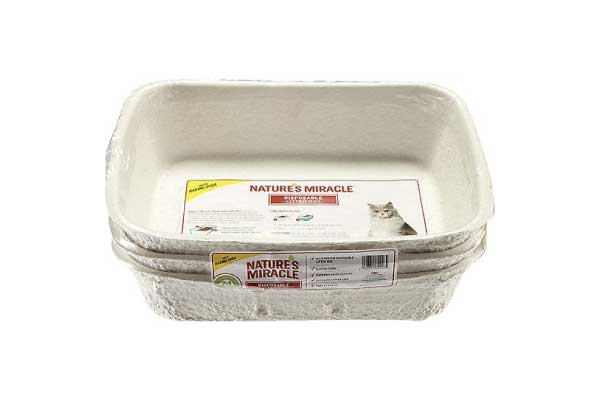
Disposable cat litter boxes are a type of litter box that are designed to be used for a limited amount of time and then thrown away. They typically consist of a cardboard or plastic tray that is pre-filled with litter, and are designed to be used for a week or two before they need to be replaced.
One of the main benefits of disposable cat litter boxes is that they are convenient and easy to use. They are pre-filled with litter, so you only have to place them in a designated area and wait for your cat to use them. They also eliminate the need for constant cleaning and litter changes.
On the downside, disposable cat litter boxes can be more expensive in the long run compared to traditional or sifting litter boxes. They also generate more waste and are not environmentally friendly. They may also run out quickly if you have multiple cats or are away from home for a long time.
8. Designer Cat Litter Boxes

Designer cat litter boxes are a type of litter box that have a unique and stylish design, often intended to blend in with home decor. They can be made of various materials such as wood, wicker, or resin, and can come in a variety of colors and patterns. They often have a removable lid or hood that covers the top and a built-in filter to reduce odors.
One of the main benefits of designer cat litter boxes is that they can add a decorative touch to your home and blend in with your existing decor. They can be a great option if you want to keep the litter box out in the open but don’t want it to be an eyesore. They also help to contain litter scatter and reduce odors.
On the downside, designer cat litter boxes can be more expensive than traditional or sifting litter boxes. They may also be less accessible for older cats or cats with arthritis or mobility issues. Also, designer cat litter boxes can be less effective for cats who are heavy diggers.
9. Dog Proof Litter Boxes

Dog proof litter boxes are a type of litter box that are designed to keep dogs from accessing and disturbing the litter inside. These boxes typically have a lid or cover that only cats can access, and may have features such as a locking mechanism or a weight-sensitive sensor that opens the lid only when a cat is using the box.
One of the main benefits of dog proof litter boxes is that they can keep dogs from eating the litter or making a mess with it. This can help to keep the litter cleaner and reduce the amount of work required to maintain the box. They are also great for households with multiple pets, where the dogs and cats share the same space.
On the downside, dog proof litter boxes may be more expensive than traditional litter boxes. They may also be less accessible for older cats or cats with arthritis or mobility issues. Also, they may not be the best option for cats who are heavy diggers, as they may struggle to access the litter.
10. Portable Litter Boxes for Travel
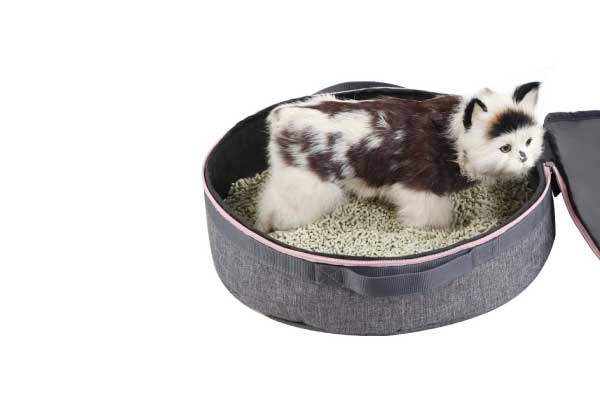
Portable litter boxes for travel is designed for easy transportation, making them great for cats who travel with their owners or for cats who need a temporary solution while away from home. These boxes are typically lightweight and collapsible and may come with a carrying handle or shoulder strap for easy transport.
One of the main benefits of portable litter boxes for travel is that they provide a familiar and comfortable place for your cat to use the bathroom while away from home. They can also be a great option for cats who are uncomfortable using unfamiliar litter or toilets.
On the downside, portable litter boxes for travel may not be as durable as traditional litter boxes and may need to be replaced more frequently. They also may not be as spacious as regular litter boxes and may not be the best option for larger cats or cats who are heavy diggers.
11. High Sided Litter Boxes

High-sided litter boxes are a type of litter box with tall walls or sides designed to contain litter and prevent it from being scattered outside the box. These boxes are typically taller than traditional litter boxes and can range from having walls that are a few inches tall to several inches.
One of the main benefits of high-sided litter boxes is that they can help to contain litter and keep it from being scattered around the house. This can help keep the area around the box cleaner and reduce the work required to maintain the box. They are also great for heavy diggers cats, as they can prevent litter from being kicked out of the box.
On the downside, high-sided litter boxes may be more expensive than traditional litter boxes. They may also be less accessible for older cats or cats with arthritis or mobility issues. Also, they may not be the best option for cats who have difficulty climbing over high walls or who prefer to have more space to move around.
Which Litter Box is Right for You?
Choosing the right litter box for your cat can be a bit of a challenge, as many different types of litter boxes are available on the market today. Some of the key factors to consider when choosing a litter box include the following:
Size of the litter box: You need to consider the size of your cat and how much space you have available for the litter box. A larger litter box may be needed for a larger cat, whereas a smaller litter box may be appropriate for a smaller cat.
Shape and height: It’s important to note that some cats prefer round or corner litter boxes and others may prefer square or rectangular boxes. Also, different cats may prefer a litter box with a high side, while other cats may prefer a box with an open front or a box with a low side.
Covered or Uncovered: Some cats may prefer covered or hooded litter boxes for privacy, while others may prefer open or uncovered boxes.
Self-cleaning or manual cleaning: Some litter boxes are designed to be self-cleaning, while others require manual cleaning. Decide which type of litter box is best for your lifestyle.
Price: Litter boxes can vary greatly in price, so it’s important to choose one that fits within your budget.
Ultimately, the best way to determine which litter box is right for your cat is to try out a few different types and see which one your cat prefers. It’s also a good idea to talk to your vet or a cat behaviorist for recommendations and tips on how to choose the best litter box for your cat.
Are Open or Closed Litter Boxes Better?
The decision of whether to use an open or closed litter box ultimately comes down to personal preference and the specific needs of your cat.
Open litter boxes are easily accessible for cats and are often the most affordable option. They are also easy to clean and may be a better option for cats who have difficulty climbing over high walls or into covered boxes.
On the other hand, closed or covered litter boxes can contain odors better and can provide more privacy for cats who prefer more enclosed spaces. They also can help to contain litter and keep it from being scattered around the house.
However, some cats may not like closed or covered litter boxes and may refuse to use them. Some cats may prefer more open spaces, and others may not like the feeling of being enclosed.
It’s worth noting that some cats prefer open litter boxes while others prefer closed litter boxes. Therefore, it’s a good idea to combine open and closed litter boxes and observe which one your cat prefers.
How Many Litter Boxes Should You Have?
It is recommended to have one more litter box than the number of cats in your household. For example, if you have two cats, it is recommended to have three litter boxes. This is because cats are territorial animals and may not want to share a litter box with other cats. Having multiple litter boxes also ensures that if one box becomes soiled or unavailable for some reason, your cat has other options.
It’s also important to consider the location of the litter boxes. You should place litter boxes in different areas of the house, so your cats have options and can choose which box they prefer to use. Avoid placing litter boxes in high-traffic areas, near loud noises, or in areas that are hard to access.
Additionally, if you have a senior cat, a cat with mobility issues or a cat that has a chronic illness, providing a litter box on each level of the house will be helpful to them.
It’s worth noting that, by providing multiple litter boxes, you will increase the chances that your cats will use them and reduce the risk of litter box avoidance which a number of factors such as dirty litter or the location of the box can cause.
Do Cats Like Deep or Shallow Litter Boxes?
In general, cats prefer shallow litter boxes. Too deep a litter box can make it difficult for them to dig, bury, and cover their waste. Cats naturally scratch and bury their waste in shallow litter boxes, which is a natural behavior. A deep litter box may also make some cats feel trapped and less likely to use it.
However, it’s also important to consider the type of litter you’re using. Clumping litter is typically shallower than non-clumping litter, so if you’re using clumping litter, you can use a shallower box.
A litter box with a depth of around 3-4 inches is generally considered to be the ideal depth for most cats. Additionally, the width and length of the box should be large enough for your cat to comfortably turn around and move in without feeling cramped.
It’s also important to note that some cats may prefer a high-sided litter box, these cats are usually older cats or cats with mobility issues.
Ultimately, the best way to determine what your cat prefers is to try different types of litter boxes and observe their behavior. If you notice that your cat is having trouble using a deep litter box, consider switching to a shallower one.
Final thoughts
A good litter box can significantly impact your cat’s comfort, health, and overall well-being. When selecting a litter box, you should consider your cat’s size, shape, height, type (covered or uncovered), self-cleaning capabilities, and price.
The best way to determine which litter box is right for your cat is to try out a few different types and see which one your cat prefers. If you keep these factors in mind and observe your cat’s behavior, you can select a litter box that your cat will like and meet all of their demands.


